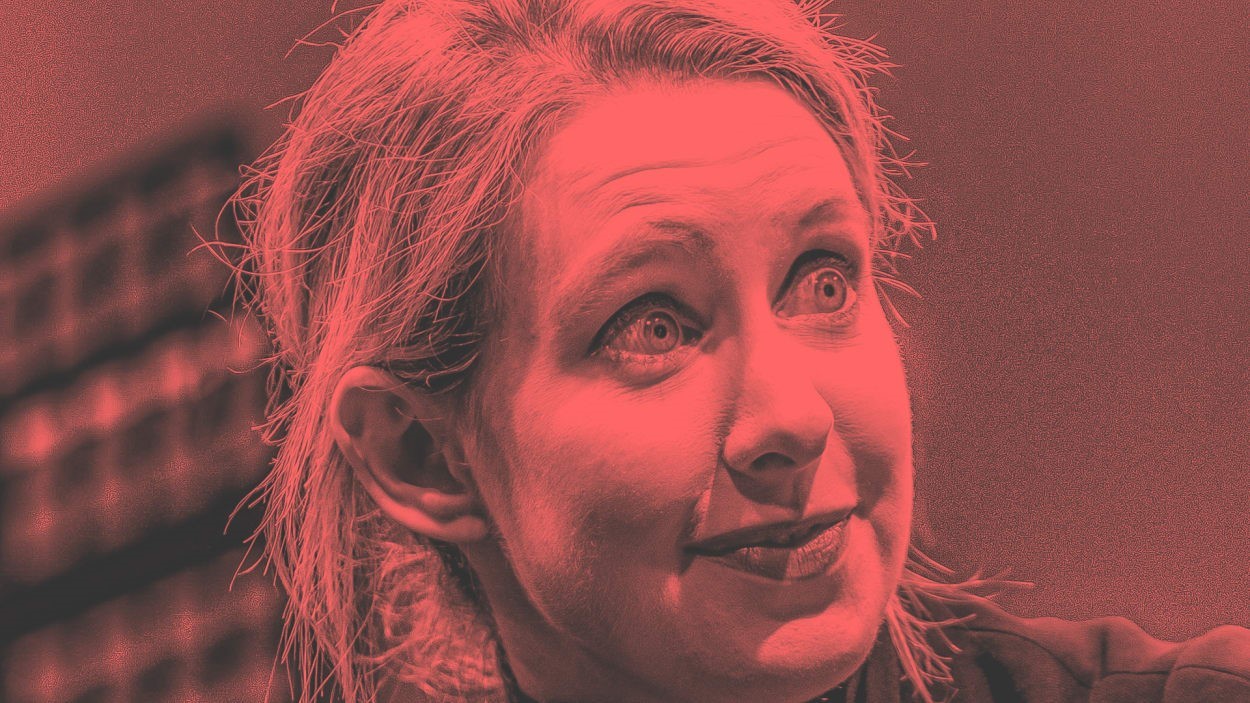Both founders and CEOs have been known to go down in flames. But in the first decades of the 21st century arguably no downfall was as spectacular as that of Elizabeth Holmes. Her story is so singular—her persona so captivating, her rise to fame so striking, and her subsequent descent so precipitous—that she is the monarch of leaders who fell from grace.
Holmes stood out from the get-go. She was, highly atypically, a woman who was a leader in the field of technology, and she was very young. She started her blood-testing company, Theranos, when she was just 19 years old. Additionally, she was preternaturally poised and persuasive. She was vocal and articulate. She was classy, well dressed, and good-looking—a tall, willowy blond, usually clad all in black, frequently a black turtleneck to emulate and evoke her idol, Apple guru Steve Jobs. Holmes had a special talent for pulling into her orbit people who were rich and powerful, especially older men. Finally, in short order, she became exceedingly wealthy, at least on paper. Theranos had become a “unicorn”—a privately held start-up company valued at over $1 billion. In fact, by 2015 Theranos was worth $9 billion. And Holmes was, at age 30, regularly described as the world’s youngest female self-made billionaire.
But the story of the rise and fall of Elizabeth Holmes transcends her persona. It includes a large cast of characters that includes the rich and powerful in business, government, and academia; Holmes’s longtime partner and lover, Sunny Balwani; members of the press, nearly all of whom were in her thrall; and her many other followers, most of whom gladly or at least willingly followed where she led, though a small number did not—and finally blew the lid off what became a sensational corporate scandal.
From the beginning, Elizabeth Holmes exhibited the leadership style that eventually did her in. She cultivated a corporate culture that all along should have raised red flags. Of her several idiosyncrasies, three stand out. First was Holmes’s extreme insistence on secrecy. Most founders are protective, eager for trade secrets not to be revealed or leaked to, or stolen by, the competition. However, some founders are more protective than others, and some, such as in this case, are obsessive. Under the thumb of Elizabeth Holmes, Theranos’s insistence on secrecy was so exceptionally restrictive and punitive it was more than a culture of concealment—it was a cult of concealment. (The term cult of secrecy was used in Joseph B. Fuller and John Masko’s case study, “Theranos: The Unicorn That Wasn’t.”)
Another red flag was Holmes’s proclivity for punishing dissent. Differences of opinion, probing questions, and suggestions of skepticism not only were not encouraged but were discouraged, effectively forbidden. Employees with concerns quickly learned not to express them. “Holmes was volatile and could lash out at employees who expressed doubts” about Theranos, whether its product or its strategic plan. The company made clear that questioning it in any way was to risk being marginalized, ostracized, even terminated.
Finally, another example of how dissent was squashed is Theranos’s treatment of those two recent college graduates employed by the company who quickly became, in reaction to their frustration, whistleblowers. Erika Cheung and Tyler Shultz worked at the company only briefly. But after repeatedly witnessing what they saw as wrongdoing they expressed their concerns to their superiors. To no avail. After being stymied and stonewalled by Theranos’s management, they decided to serve as a source for John Carreyrou, the reporter who broke the story that led to the scandal. According to Carreyrou in his book Bad Blood, Cheung and Shultz were “appalled by the lack of scientific rigor that had gone into validating [Theranos] tests. . . . The company routinely ignored quality-control failures and test errors and showed a complete disregard for the well-being of patients.”
After he had worked at Theranos for eight months, Tyler was so concerned about what was happening at the company that he sent an email to Holmes complaining that Theranos had doctored research and ignored failed quality-control checks. Holmes in turn forwarded Tyler’s email to Balwani, who belittled Tyler’s knowledge of science and suggested that he had secured his job only because of nepotism.
“The only reason I have taken so much time away from work to address this personally is because you are [former Secretary of State George] Shultz’s grandson,” wrote Balwani to Tyler in an email. That same day Tyler Shultz quit his job, only to be told by his frantic mother that Holmes had called his grandfather to warn him that Tyler would “lose” if he challenged or questioned Theranos. But the younger Shultz was not deterred. Using an alias, he contacted New York State’s public health lab and alleged that Theranos had manipulated its proficiency testing. In 2015 he spoke to John Carreyrou, for whom he, like Cheung, became an important source.
The year 2015 was the turning point. It was then it became clear that Elizabeth Holmes was a victim of her own success. She had excelled at selling but she had failed dismally at delivering. With every passing month the gap between promises made and promises kept became more apparent and acute. In April 2015 an article in Yahoo Finance carried this headline: “Scientists Are Skeptical About the Secret Blood Test That Has Made Elizabeth Holmes a Billionaire.” Among the problems it described were Theranos’s failure to publish a single scientific, peer-reviewed study that compared its blood tests to those already in use. Nor did the company allow independent experts access to its labs, using as an excuse the need to protect intellectual property. By the end of the year The New York Times pointed out that though Theranos claimed to have conducted “millions of tests,” it had not once permitted its technology to be objectively assessed.
It was The Wall Street Journal’s Carreyrou who broke Theranos’s back. Once he became involved in the story, his reporting was relentless. Even the first of his many related articles, which ran in October 2015, suggested his investigation would be devastating. In his subsequent book, Bad Blood, he described the essence of his initial piece: “In addition to revealing that Theranos ran all but a small fraction of its tests on conventional machines [as opposed to its own Edison], laying bare its proficiency-testing shenanigans and its dilution of finger-stick samples, it raised serious questions about the accuracy of its own devices.”
But Carreyrou focused on more than Theranos’s science; he was interested as well in its organizational culture. For example, when employees showed Sunny Balwani some unsettling lab results or registered any other sort of significant complaint, instead of being open to new and potentially important information, he was furious, as had happened with Tyler Shultz. He wrote to Holmes that “samples should have never run on Edisons to begin with” and that he was “extremely irritated and frustrated by folks with no legal background taking legal positions and interpretations on these matters.” In March 2016 Carreyrou and a colleague wrote in The Wall Street Journal that according to a federal inspection report, “the blood-testing devices that Theranos Inc. touted as revolutionary often failed to meet the company’s own accuracy requirements for a range of tests, including one to help detect cancer.”
The investigation led by Carreyrou was unstoppable, even though Holmes and her minions tried. Federal agencies started to smell blood, so to speak. Companies that had signed contracts with Theranos, including Safeway, voided those deals. Lawsuits were filed, such as with Walgreens, which sued for $140 million, alleging breach of contract. (That case was settled for an undisclosed amount.) Partnerships fell apart. Ordinary people who had had experiences with Theranos’s testing, such as doctors and patients from the Phoenix area, complained about everything from false advertising to mistaken testing. And in March 2018 the Securities and Exchange Commission accused Theranos of perpetrating an “elaborate, yearslong fraud” against investigators, partners, and patients.
Three months later, Holmes and Balwani were indicted by a federal grand jury for wire fraud. Three months after that, wrote Fuller and Masko in their case study, “Theranos, with just 25 employees remaining, went into credit default and closed its doors.”
Elizabeth Holmes’s immediate response to the calamity was curious. Former employees later reported that throughout this final, dismal period she acted bizarrely, as if nothing were wrong. “The company is falling apart, there are countless indictments piling up, employees are leaving in droves, and Elizabeth is just weirdly chipper,” reported one former senior executive. While this would seem on the surface to be surprising, perhaps it is not. Perhaps it was simply in keeping with someone who, for the better part of two decades, initially had a dream and then chose to live in a dream world.
Whatever the legal culpability of Elizabeth Holmes, this much is clear. She fabricated and fantasized. She concealed and confabulated. She lied and denied. She looked like a Silicon Valley superstar. She posed like a Silicon Valley superstar. She promised like a Silicon Valley superstar. But she did not deliver like a Silicon Valley superstar. In the end, whatever her remarkable skills and talents, she was a hustler, a poser, a promoter, a trickster, a con artist, a fibber, a fabler, and a falsifier.
Holmes’s downfall is an exemplar. First, of the perils of bad leadership, specifically of rigid leadership. Rigid leadership is when the leader and at least some followers are stiff and unyielding. Although they may be competent, they are unable or unwilling to adapt to new ideas, new information, or changing times. Holmes was nothing if not a rigid leader—so rigid that she was effectively impervious to the growing mountain of doubt that her dream would be, could be, realized. Had she been able to hear the growing concerns, to grasp the hard, sad evidence that was piling up, it might have been possible for her to correct course and save herself and her company. But she could not.
Second, Holmes’s downfall testifies yet again to how bad leadership gets worse over time unless and until something or someone intervenes—in this case, most importantly, John Carreyrou. It took years before the secrecy, the obstinacy, and the rigidity at Theranos hardened into fatal flaws.
Excerpted with permission from Leadership From Bad to Worse by Barbara Kellerman. Copyright @2024 by Oxford University Press.
Fast Company – work-life
(7)







